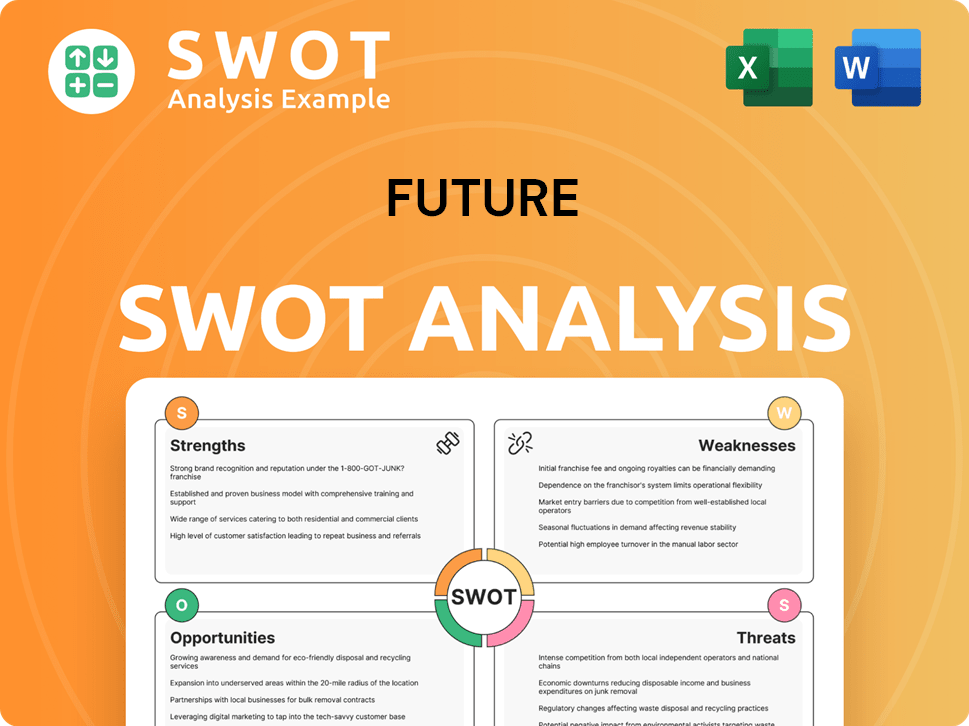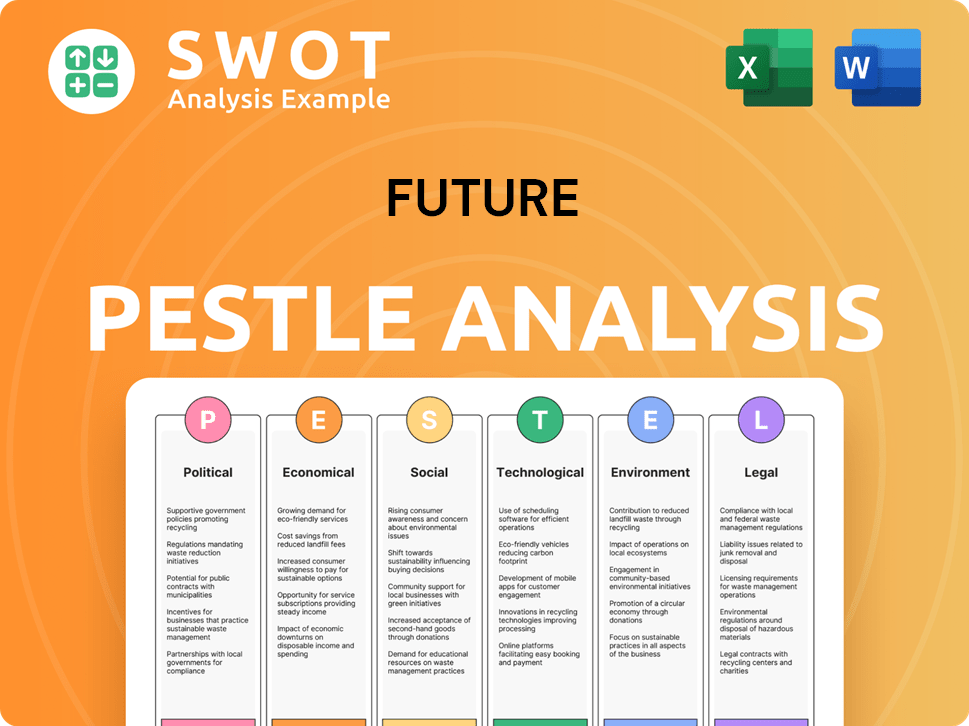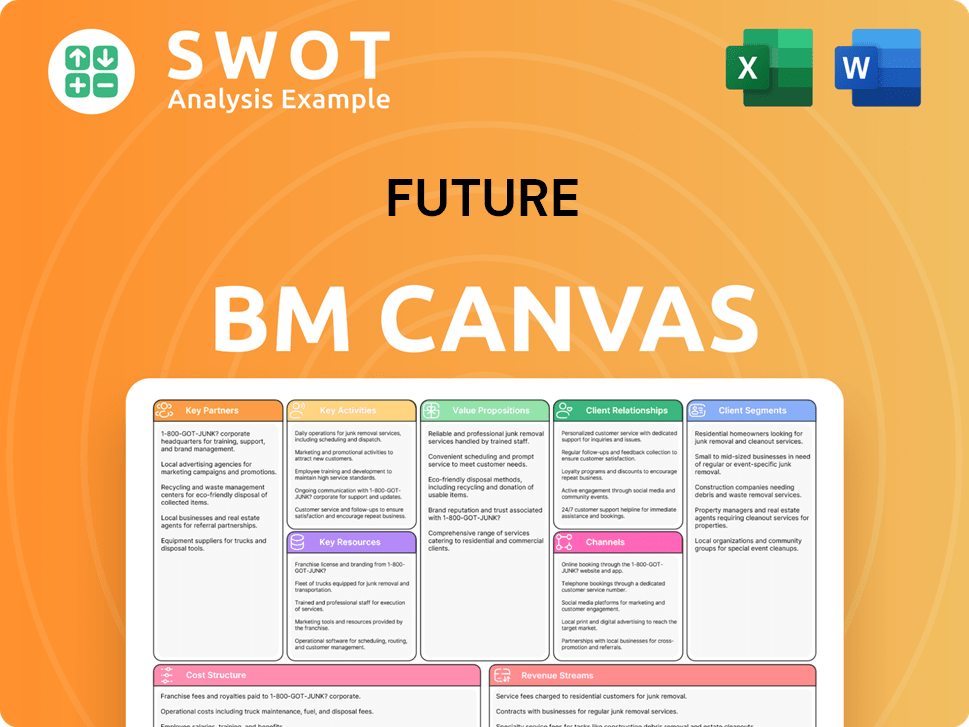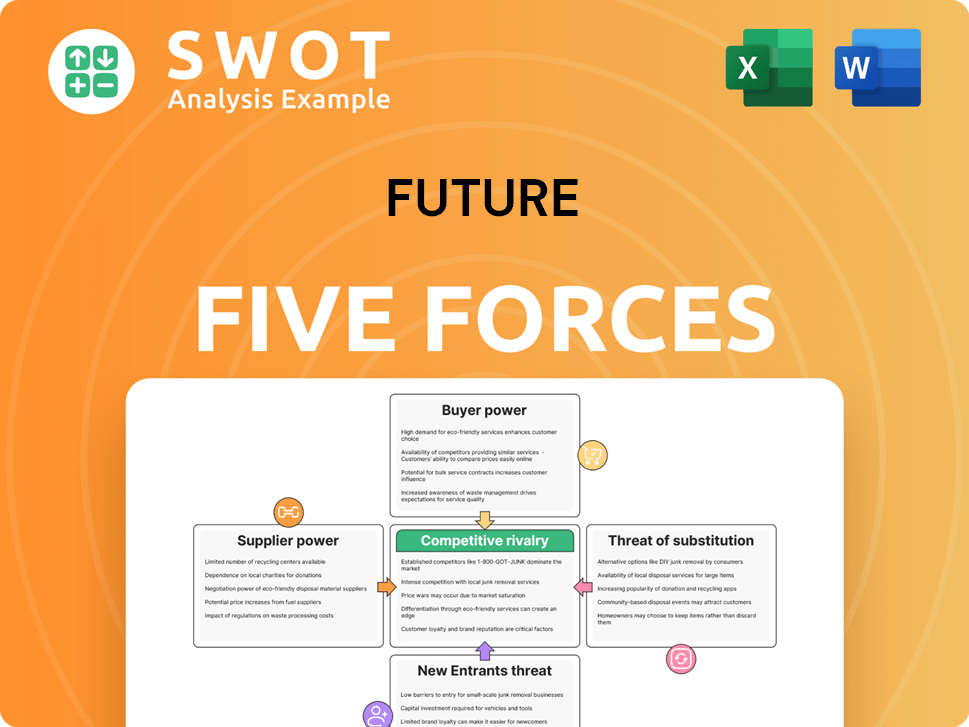Future Bundle
How Does the Future Company Navigate Its Competitive Arena?
Future PLC, a media titan born in the digital age, isn't just surviving; it's redefining the game. But in a media market saturated with content, who are its fiercest rivals, and how does Future maintain its edge? This exploration dives deep into the Future SWOT Analysis, dissecting the competitive landscape to uncover the strategies that drive its success.

Understanding the Future company's competitive landscape is vital for anyone tracking market analysis and industry trends. This analysis will provide insights into their business strategy, helping you identify competitive advantage and potential threats. By examining the competitive landscape, we can better understand how Future PLC positions itself for future growth and navigates the complexities of a rapidly evolving media environment, offering a roadmap for anyone looking to predict future market trends.
Where Does Future’ Stand in the Current Market?
Future PLC holds a strong market position within the specialist content media sector. Its diverse portfolio of brands and multi-platform approach drives this position. The company has established itself as a leader in several categories, particularly in technology and gaming.
Future's primary offerings include digital content, print magazines, and events. These are designed to serve highly engaged audiences. The company's geographic presence is strong in the UK and US, with a growing international footprint. Future caters to a broad spectrum of customer segments, from tech enthusiasts and gamers to musicians and home improvement aficionados.
Over time, Future has strategically shifted its positioning. It moved from a print-based publisher to a digitally-led enterprise. This digital transformation has allowed the company to reach a wider audience and enhance monetization through e-commerce and affiliate revenue. This shift has helped maintain robust financial health.
Future's digital content brands, such as TechRadar and PC Gamer, consistently rank among the top-tier content providers globally. This dominance is a key factor in its market position. These brands attract large, engaged audiences.
The company's multi-platform approach, including digital content, print magazines, and events, allows it to reach a wider audience. This strategy enhances its ability to generate revenue. It also strengthens its position in the market.
Future has a strong presence in the UK and US markets. It is also expanding its international footprint. This geographic diversity helps to mitigate risks. It also opens up new opportunities for growth.
Future serves a broad range of customer segments. These include tech enthusiasts, gamers, musicians, and home improvement aficionados. This diverse customer base helps to stabilize revenue streams. It also provides opportunities for cross-selling.
Future's financial performance reflects its strong market position. For the six months ended March 31, 2024, Future reported revenue of £391.5 million. The adjusted operating profit was £113.6 million, demonstrating a healthy margin. The company continues to strengthen its position in key digital advertising and e-commerce segments. It leverages its proprietary technology and audience data to drive performance. For a deeper understanding of its financial structure, consider exploring the Revenue Streams & Business Model of Future.
Future's ability to adapt to industry trends is crucial for maintaining its competitive advantage. The shift towards digital platforms and e-commerce is a key strategy. This allows the company to capture a wider audience and increase revenue.
- Digital Transformation: Future's focus on digital content and platforms is a key driver of its success.
- E-commerce and Affiliate Revenue: These are essential for enhancing monetization.
- Strategic Partnerships: Collaborations with other companies can expand reach and create new revenue streams.
- Data-Driven Decisions: Using audience data to improve content and advertising performance.
Future SWOT Analysis
- Complete SWOT Breakdown
- Fully Customizable
- Editable in Excel & Word
- Professional Formatting
- Investor-Ready Format

Who Are the Main Competitors Challenging Future?
The competitive landscape for Future PLC is multifaceted, encompassing both direct and indirect competitors across its diverse content verticals. A thorough market analysis reveals that Future PLC operates in a dynamic environment, constantly shaped by evolving industry trends and technological advancements. Understanding these dynamics is crucial for developing effective business strategy and maintaining a competitive advantage.
Direct competitors include established media companies that compete for audience attention and advertising revenue. Indirect competition comes from a broader range of entities, including social media platforms and individual content creators. The ability to adapt and innovate is essential for navigating this complex environment and securing a strong market position.
Future PLC faces a variety of direct competitors, particularly in the technology and gaming sectors. One key rival is Ziff Davis, which owns brands like IGN and Mashable. These companies compete directly for audience share and advertising revenue through similar multi-platform strategies. Dotdash Meredith, with its extensive portfolio of digital and print brands, including those in the home and garden segments, also poses a significant challenge, directly competing with Future's presence in those markets. These competitors often utilize content innovation, aggressive digital marketing, and strategic acquisitions to gain market share.
Direct competitors are media companies with similar content offerings and target audiences.
Indirect competitors include social media platforms, search engines, and individual content creators.
Competitors vie for market share through content innovation, digital marketing, and acquisitions.
Adapting and innovating content is crucial for staying competitive.
Effective digital marketing strategies are key to attracting audiences.
Acquisitions can reshape the competitive landscape.
Indirect competition is fierce, coming from platforms like YouTube and Twitch, which capture audience attention and advertising revenue. E-commerce sites with integrated content and affiliate marketing also blur the lines between media and retail, posing another challenge. The competitive landscape is further shaped by mergers and acquisitions, such as Axel Springer's continued expansion, and the emergence of AI in content creation, which could disrupt traditional media models. To gain insights into Future PLC's performance, you can review a detailed competitive landscape analysis.
Future PLC must consider several key factors to maintain its competitive edge.
- Content Innovation: Continuously develop new and engaging content.
- Digital Marketing: Utilize effective digital marketing strategies.
- Strategic Partnerships: Form alliances to expand reach and capabilities.
- AI Integration: Explore and integrate AI technologies.
- Market Analysis: Regularly conduct market analysis to identify opportunities and threats.
Future PESTLE Analysis
- Covers All 6 PESTLE Categories
- No Research Needed – Save Hours of Work
- Built by Experts, Trusted by Consultants
- Instant Download, Ready to Use
- 100% Editable, Fully Customizable

What Gives Future a Competitive Edge Over Its Rivals?
The competitive advantages of Future PLC are built on specialist content, proprietary technology, and diverse revenue streams. These elements provide a strong foundation for the company's success in the evolving market. A deep understanding of niche content creation allows Future to build strong brand loyalty and command premium advertising rates. This approach has allowed Future to establish itself as a key player in various sectors, including gaming, music, and technology.
Future's proprietary technology, particularly the Hawk platform, offers a significant edge. Hawk enhances affiliate revenue by connecting content with relevant products and services. This seamless integration of product recommendations and purchasing options within editorial content drives substantial revenue through affiliate commissions and e-commerce. This strategy sets Future apart from traditional publishers, which are often heavily reliant on advertising revenue.
Furthermore, Future's diversified revenue model, which includes digital advertising, print subscriptions, events, and e-commerce, provides resilience against market fluctuations. The company's ability to leverage its content across multiple platforms maximizes reach and engagement. Its strong brand equity, with over 200 brands, fosters customer loyalty and attracts a broad advertiser base. These advantages have evolved from its early focus on niche print magazines to a sophisticated digital-first approach, leveraging data analytics and technological innovation to enhance content delivery and monetization.
Future excels in creating niche content that resonates with specific communities, fostering strong brand loyalty. This approach allows for premium advertising rates and positions brands like TechRadar and PC Gamer as leaders in their respective verticals. This focus on specialized content is a key element in the company's competitive advantage within the Target Market of Future.
The Hawk platform is a sophisticated e-commerce content platform that optimizes affiliate revenue. It seamlessly integrates product recommendations within editorial content, driving significant revenue through affiliate commissions. This technology is a key differentiator, enabling Future to generate revenue beyond traditional advertising models.
Future's diversified revenue model includes digital advertising, print subscriptions, events, and e-commerce, providing resilience against market fluctuations. This approach maximizes reach and engagement by leveraging content across multiple platforms. The company's portfolio of over 200 brands supports customer loyalty and attracts a diverse advertiser base.
While aspects like content creation can be imitated, the combination of specialist content, proprietary technology, and a diversified revenue model creates a sustainable competitive moat. This integrated approach allows Future to maintain a strong position in the competitive landscape and adapt to evolving industry trends.
Future's competitive advantages are rooted in its specialist content, proprietary technology, and diversified revenue streams. These elements work together to create a sustainable competitive edge in the market. By focusing on niche content, leveraging technology for e-commerce, and diversifying its revenue streams, Future has built a resilient business model.
- Specialist Content: Deep expertise in creating engaging content that resonates with specific audiences.
- Proprietary Technology: Hawk platform optimizes affiliate revenue and integrates product recommendations.
- Diversified Revenue: Multiple income streams provide resilience against market fluctuations.
- Strong Brand Portfolio: Over 200 brands foster customer loyalty and attract advertisers.
Future Business Model Canvas
- Complete 9-Block Business Model Canvas
- Effortlessly Communicate Your Business Strategy
- Investor-Ready BMC Format
- 100% Editable and Customizable
- Clear and Structured Layout

What Industry Trends Are Reshaping Future’s Competitive Landscape?
The media industry is in constant flux, driven by technology, consumer behavior, and regulatory changes. This dynamic environment presents both challenges and opportunities for Future PLC. Understanding the competitive landscape and adapting to these shifts is essential for sustained success. A strong business strategy is crucial for navigating these changes and achieving a competitive advantage.
Future PLC must strategically position itself to capitalize on emerging trends while mitigating risks. This involves a deep dive into industry trends, anticipating future challenges, and identifying opportunities for growth. The ability to adapt and innovate will determine its long-term viability in the ever-evolving media sector.
Fragmentation of audience attention across numerous platforms and content creators is a key trend. Short-form video, influencer marketing, and AI-generated content are reshaping traditional editorial models. These shifts impact advertising revenue and audience engagement. For example, the global digital advertising market is projected to reach over $876 billion by 2028, according to Statista.
Regulatory changes, particularly concerning data privacy and online advertising, introduce operational complexities and compliance costs. Economic uncertainties and fluctuating advertising spend directly impact financial performance. The rise of AI-generated content also poses a threat to content originality. The cost of compliance with data privacy regulations continues to rise; for instance, the GDPR fines have totaled over €1.6 billion since its enforcement.
Growing demand for high-quality, specialized content, especially in niche communities, aligns with Future’s core strategy. Expansion of e-commerce and affiliate marketing presents significant growth avenues. Emerging markets offer untapped potential for audience growth and content localization. The global e-commerce market is expected to reach $8.1 trillion in 2026, according to Statista. Strategic partnerships can unlock new distribution channels and monetization models.
Future PLC should invest in proprietary technology and expand content verticals. Explore new geographical markets and focus on data-driven content creation and monetization. A focus on building resilience and adapting to disruptions is critical. To further expand, Future can explore strategic partnerships, as discussed in Growth Strategy of Future.
To thrive in the competitive landscape, Future PLC should prioritize several key strategies. These strategies will help the company to navigate the dynamic media environment and secure a competitive advantage.
- Invest in data analytics to understand audience behavior and content performance.
- Diversify content offerings to include short-form video and AI-generated content.
- Explore strategic partnerships with technology providers and e-commerce platforms.
- Expand into emerging markets with localized content and marketing strategies.
Future Porter's Five Forces Analysis
- Covers All 5 Competitive Forces in Detail
- Structured for Consultants, Students, and Founders
- 100% Editable in Microsoft Word & Excel
- Instant Digital Download – Use Immediately
- Compatible with Mac & PC – Fully Unlocked

Related Blogs
- What are Mission Vision & Core Values of Future Company?
- What is Growth Strategy and Future Prospects of Future Company?
- How Does Future Company Work?
- What is Sales and Marketing Strategy of Future Company?
- What is Brief History of Future Company?
- Who Owns Future Company?
- What is Customer Demographics and Target Market of Future Company?
Disclaimer
All information, articles, and product details provided on this website are for general informational and educational purposes only. We do not claim any ownership over, nor do we intend to infringe upon, any trademarks, copyrights, logos, brand names, or other intellectual property mentioned or depicted on this site. Such intellectual property remains the property of its respective owners, and any references here are made solely for identification or informational purposes, without implying any affiliation, endorsement, or partnership.
We make no representations or warranties, express or implied, regarding the accuracy, completeness, or suitability of any content or products presented. Nothing on this website should be construed as legal, tax, investment, financial, medical, or other professional advice. In addition, no part of this site—including articles or product references—constitutes a solicitation, recommendation, endorsement, advertisement, or offer to buy or sell any securities, franchises, or other financial instruments, particularly in jurisdictions where such activity would be unlawful.
All content is of a general nature and may not address the specific circumstances of any individual or entity. It is not a substitute for professional advice or services. Any actions you take based on the information provided here are strictly at your own risk. You accept full responsibility for any decisions or outcomes arising from your use of this website and agree to release us from any liability in connection with your use of, or reliance upon, the content or products found herein.